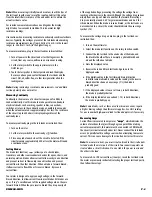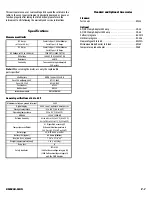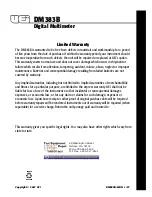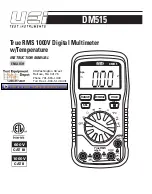
Operating Instructions
Functional Description
The DM383B is designed to make basic electrical measurements
quickly and easily. The LCD provides range and function information
while the extra large numerical data display can be monitored from
a distance.
This is a 4000 count, manual-ranging digital multimeter that employs
high input impedance to ensure accurate readings and circuit isolation
for digital and analog devices.
The input ports use standard four-millimeter insulated-plug test leads
(provided). Maximum measurement values are 1000 Volts DC, and 750
Volts AC (CAT II) or 600 V AC/DC (CAT III) and 10 amps AC or DC.
Meter Power
The DM383B is powered on and off using the push-button on the far
left, which is marked with the international on/off symbol ( ). This
instrument will remain on until manually turned off to allow constant
monitoring or maximum value recording.
Selecting the Proper Test Lead Ports
The test leads must be plugged into the proper ports to make
electrical measurements. Press the test lead plugs firmly into the
meter ports to ensure they are fully seated.
The black test lead will be plugged into:
• COM:
For all measurements
The red test lead will be plugged into:
• V
Ω
:
For testing volts AC or DC, ohms, continuity,
and diodes
• µA mA:
For testing amps AC or DC with values below
400 milliamps
• A:
For testing amps AC or DC with values up to
(not exceeding) 10 amps
MAX Recording
After selecting your desired mode and range, you can enable the
MAX recording function. This function allows the meter to display
the highest numerical value obtained in the selected mode. This
numerical data is not reset when the rotary switch is moved from
one function to another, yet it will display higher values if they are
provided by the newly selected function. For best results, set the
range and function you intend to record prior to pressing the MAX
push-button then leave the function selector in that position.
Hold
The HOLD push-button freezes the numerical data displayed on the
LCD at the moment it is pressed. To engage data hold, press the HOLD
push-button, located on the right side on the face of the instrument.
When this function is active, the word
“HOLD”
appears on the left side
of the digital display. To cancel data hold, press the HOLD button
again. The numerical value will remain displayed even if the rotary
dial is moved from its original position.
DM383B-MAN
P. 3
Rotary Function Switch
The rotary function select switch is used to select the measurement
function and range. The operator has complete control over the
function and resolution of the measurement.
CAUTION!
While this meter is manufactured with a number of built in fail-safe, the
potential to damage the meter or blow a fuse due to improper
use does exist. Set the rotary function select switch to the appropriate
setting before connecting test leads, or applying power to circuits
under test.
Measure Voltage
WARNING!
To avoid the risk of electrical shock and instrument damage, input
voltages must not exceed specified limits.
DO NOT
attempt to take any
unknown voltage measurements that may be in excess of these values.
NOTE:
When taking voltage measurements your meter must be
connected in parallel to the circuit, or circuit element, under test.
To measure DC or AC volts plug in the test leads as instructed, then:
1. Turn on the multimeter.
2. Set the rotary function switch to one of the DC volt (DCV)
or AC volt (ACV) positions, as appropriate. If you do not know
the maximum value of the voltage to be measured, start at the
highest range and reduce the setting as required to obtain
satisfactory resolution.
3. Disconnect the power from the circuit to be tested (if pra c t i ca l ) .
4. Connect the test leads to the circuit to be tested.
5. Reapply power to the circuit (when applicable).
6. Read the measured voltage on the display.
NOTE:
When measuring DC voltage, if the voltage on the red test lead
is lower (more negative) than that on the black test lead, the negative
polarity sign (a minus symbol) will appear on the left of the display.
7. Disconnect power to the circuit under test before removing
the test leads (if practical).
Measuring Resistance
Resistance is the measure of a component or circuit’s tendency to
oppose current flow. Because of the many factors that affect resistance,
the most accurate measurements are made when components under
test are isolated from other components or circuits. It is critical to the
accuracy of the measurement that you remove all power to the circuit
under test when making resistance measurements. If the component
or circuit under test cannot be isolated, turn off all power sources
and discharge all capacitors affecting the circuit to be tested before
attempting the in-circuit measurement. This meter may be damaged if
more than 600 volts are present.



























